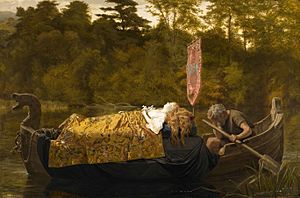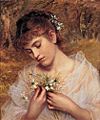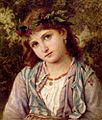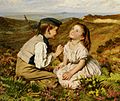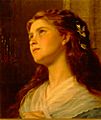Sophie Gengembre Anderson facts for kids
Quick facts for kids
Sophie Gengembre Anderson
|
|
|---|---|
| Born |
Sophie Gengembre
1823 Paris, France
|
| Died | 10 March 1903 Falmouth, Cornwall, England
|
| Resting place | Falmouth Cemetery at Swanvale, Falmouth, England |
| Nationality | French-born British |
| Education | Charles de Steuben |
| Known for | Painting |
|
Notable work
|
|
| Movement |
|
| Spouse(s) | Walter Anderson |
Sophie Gengembre Anderson (born 1823 – died 1903) was a talented artist. She was born in France but became a British citizen. Sophie was known for her paintings of children and women. She often showed them in peaceful countryside scenes.
Sophie started her career by making prints (lithography) and painting portraits. She worked with Walter Anderson, who later became her husband. Together, they painted portraits of important church leaders in America. One of her famous paintings, Elaine, was the first artwork by a woman artist bought by a public collection. Another painting, No Walk Today, sold for over £1 million!
Contents
Early Life and Art Training
Sophie Gengembre was born in Paris, France. Her father, Charles Antoine Colomb Gengembre, was an architect and artist. Her mother was Marianne Farey, who was English.
Sophie's family lived in Paris when she was very young. Her father knew many artists and thinkers. From 1829 to 1843, her family lived in a quiet part of France. When Sophie was 17, she became very interested in art. This happened after a portrait painter visited her town.
Sophie mostly taught herself how to paint. However, she did study portrait painting for a short time. This was around 1843, when she lived with family friends in Paris. Her teacher was Charles de Steuben. He left for Russia soon after she started, so her formal training was brief.
Moving to the United States
Sophie's family moved from France to the United States. They left to escape the revolution of 1848. They first settled in Cincinnati, Ohio. There, Sophie met Walter Anderson, who would become her husband. He was also an artist from Britain.
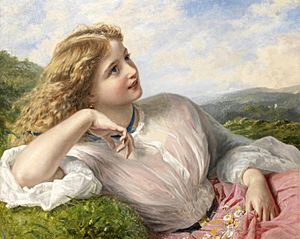
In 1849, Sophie's paintings were shown in an art gallery. These included portraits and scenes of the French countryside. She also created illustrations for a book called Historical Collections of the Great West in 1851. Sophie worked with Walter Anderson on portraits of church leaders. She also had her own portrait painting business.
Later, Sophie lived in Manchester, Pennsylvania, with her parents. It is believed she married Walter Anderson there. She also worked for a company that made color prints.
Life and Art in Europe
In 1854, Sophie and Walter Anderson moved to London, England. Sophie showed a painting of fruits, vegetables, and fish there. It was called An American Market Basket. People thought it was a wonderful painting. Her other paintings were also shown at the Royal Academy.
The Andersons returned to Pennsylvania for a visit in 1858. Sophie showed her art in Pittsburgh during this time. In 1860, both she and her husband had their work shown in New York. Then, around 1863, they settled back in London.
Sophie's art was shown in many important places. These included the Royal Academy and the Royal Society of British Artists. Her painting, Elaine, was a very important purchase. It was one of the first times a public collection bought art from a living woman artist.
Another of her paintings, Foundling Girls at Prayer in the Chapel, is in the Foundling Museum. This painting shows girls of different ages praying. It also shows what they wore and how religion was part of their lives. This fits well with Sophie's usual style of painting children and women.
To help with her health, Sophie and Walter moved to the Isle of Capri in 1871. Capri is an island in Italy. Many artists lived there at the time. They lived in a house with a large garden and painted. Sophie created Italian-themed paintings. These included scenes of peasant women and children. It was hard for women to be successful artists back then. But these paintings, often done by men, helped her have a great career.
Later Years and Passing
In 1894, Sophie and Walter moved back to England. They lived in Falmouth, a town in Cornwall. Sophie continued to show her art in London. Walter passed away on January 11, 1903. Just two months later, on March 10, 1903, Sophie also passed away at home. She was buried in the same grave as her husband in Falmouth.
Sophie's Legacy
Sophie Anderson's painting No Walk Today set a world record price. It sold for over £1 million in 2008. This made her "Cornwall's first million-pound female artist."
Her artwork can be found in many museums and galleries. Most of these are in the United Kingdom. Some places include the Leicester Museum & Art Gallery, Russell-Cotes Art Gallery & Museum, and the Walker Art Gallery in Liverpool.
Gallery
See also
 In Spanish: Sophie Gengembre Anderson para niños
In Spanish: Sophie Gengembre Anderson para niños
- List of works by Sophie Gengembre Anderson



